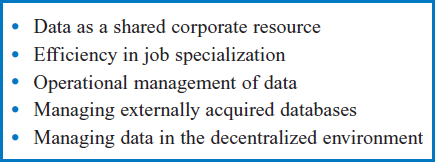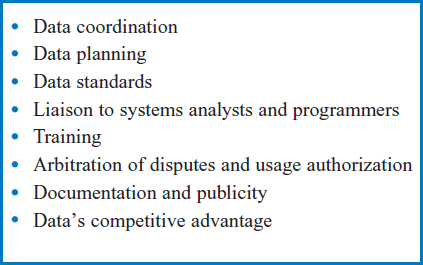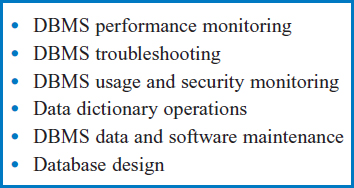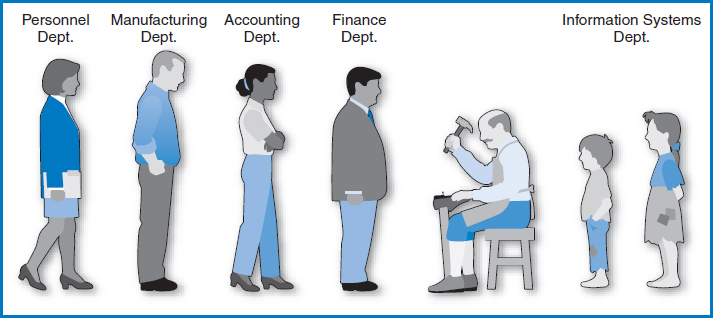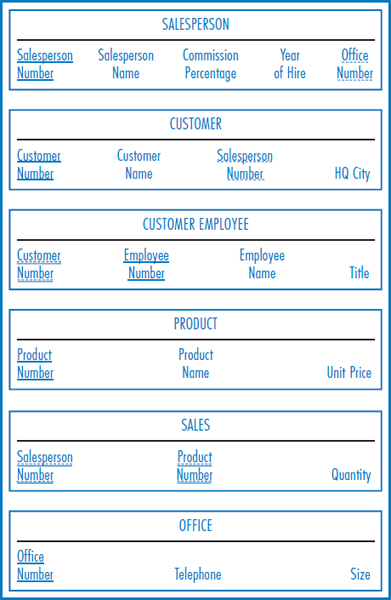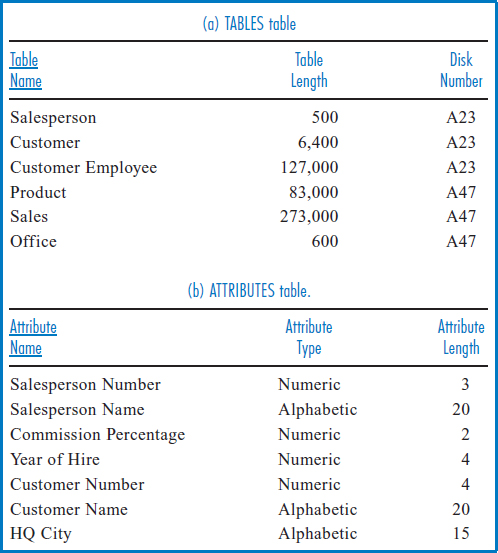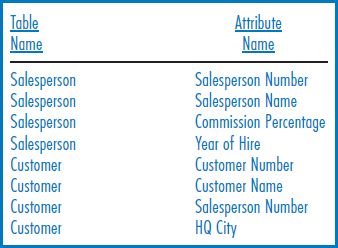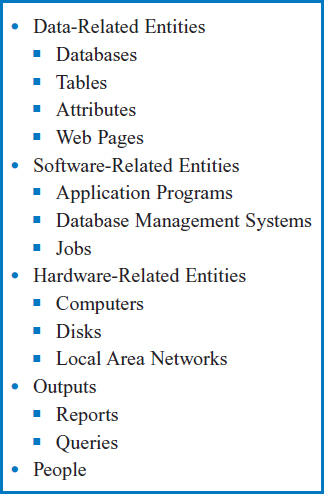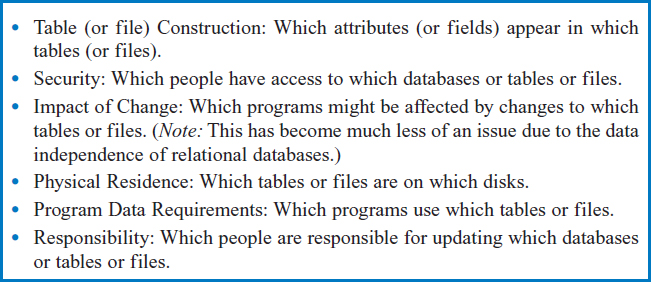CHAPTER 10
DATA ADMINISTRATION, DATABASE ADMINISTRATION, AND DATA DICTIONARIES
Advanced technologies are only as effective as the people who guide them. This is true of jet airliners, x-ray imaging devices, nuclear power plants, and certainly computers! In the late 1960s, as early navigational database management systems were starting to come into use, a few forward-looking companies began to recognize the need for a department whose job it would be to manage the DBMS and its environment. As the years went on, some of these groups gained responsibility over data in non-DBMS files as well. In addition, some of them advanced from managing data only on an operational basis to performing in addition strategic planning, policy setting, and other broader-based duties. This chapter will describe the functions and groups that companies create to manage their data and their database environment.
OBJECTIVES
- Define and compare data administration and database administration.
- List and describe the advantages of data administration and database administration.
- List and describe the responsibilities of data administration and database administration.
- Explain the concept of metadata.
- List and describe such metadata realizations as passive and active data dictionaries, relational DBMS catalogs, and data repositories.
CHAPTER OUTLINE
Introduction
The Advantages of Data and Database Administration
- Data as a Shared Corporate Resource
- Efficiency in Job Specialization
- Operational Management of Data
- Managing Externally Acquired Databases
- Managing Data in the Decentralized Environment
The Responsibilities of Data Administration
- Data Coordination
- Data Planning
- Data Standards
- Liaison to Systems Analysts and Programmers
- Training
- Arbitration of Disputes and Usage Authorization
- Documentation and Publicity
- Data's Competitive Advantage
The Responsibilities of Database Administration
- DBMS Performance Monitoring
- DBMS Troubleshooting
- DBMS Usage and Security Monitoring
- Data Dictionary Operations
- DBMS Data and Software Maintenance
- Database Design
Data Dictionaries
- Introduction
- A Simple Example of Metadata
- Passive and Active Data Dictionaries
- Relational DBMS Catalogs
- Data Repositories
Summary
INTRODUCTION
The “people side” of database management has two parts: data administration and database administration. Data administration is a planning and analysis function that is responsible for setting data policy and standards, for promoting the company's data as a competitive resource, for accounting for the use of data, and for providing liaison support to systems analysts during application development. The database administration function is more operationally oriented and is responsible for the day-to-day monitoring and management of the company's various active databases, as well as for providing liaison support to program designers during application development. Database administration typically carries out many of the policies set by data administration. This chapter will also describe a class of software tools, known generically as “data dictionaries,” that the data administration and database administration functions can use to help manage their company's data.
CONCEPTS IN ACTION
10-A ESPN
ESPN, headquartered in Bristol, CT, is a major sportscasting network whose ventures include cable television, radio, sports news, a magazine, and even wireless sports updates. ESPN acquires sports programming, broadcasts it, and stores it. The backbone of this complex operation is a database application called the Network Cable System (NCS). NCS is implemented in Oracle and runs on an IBM large-end Unix server.
NCS is a cradle-to-grave system that tracks all of ESPN's broadcasting business from the time programming is acquired until long after it is shown. It tracks and stores the contracts for the programming, schedules the programming, coordinates the commercial advertisements that will be shown during the broadcasts, and manages the tape library of current and historical sports footage. It even has pointers to digitally stored advertisements. Finally, it stores Nielsen ratings that indicate how many people watched its broadcasts, on a historical basis.
One of the main relational tables in the system is the Program Schedule table. With one record per sports event, this table coordinates the broadcast schedule for ESPN, ESPN2, ESPNNews, ESPNClassic, and other operations. There is also an Airings table and a Units table that records commercials aired, with 12 million records dating back to 1993. These can be linked back to the events in the Program Schedule table. These database tables are used both in the operational and analytical modes. Operationally on a day-to-day basis, they, for example, manage the check-in and check-out of tapes from the tape library. But they are also used to analyze the historical broadcast, Nielsen, and advertising data to learn the effectiveness of the broadcasting and the value of the advertising.

Photo Courtesy of ESPN
THE ADVANTAGES OF DATA AND DATABASE ADMINISTRATION
The initial question is, why do companies need these data and database administration departments? What value do they add? Are they just additional “cost centers” that don't produce revenue? Indeed, at one time or another, most companies have struggled with these questions. But in today's heavily data-intensive, information-dependent business environment, these functions are recognized as being more important than ever. The reasons, as listed in Figure 10.1, are explained next.
Data as a Shared Corporate Resource
Data is a corporate resource that has taken its rightful place alongside money, plant and equipment, personnel, and other corporate resources. Virtually all aspects of business have become dependent on their information systems and the data flowing through them. Today's organizations could not function without their vast stores of personnel data, customer data, product data, supplier data, and so forth. Indeed, data may well be the most important corporate resource because, by its very nature, it describes all of the others. Furthermore, the effective use of its data can give a company a significant competitive advantage. Whether it is used for supply chain management, customer service, or advanced marketing applications, a company's data can have a real impact on its share of the marketplace and on its bottom-line profitability.
FIGURE 10.1 The advantages of data and database administration
But all resources tend to be scarce (is there ever enough money to go around?) and there is typically internal competition for them. Data is no exception. As more and more corporate functions seek the same data for their work, bottlenecks can form and the speed of accessing the data can slow. Companies have responded to this in a variety of ways, including bringing in faster computers and making copies of the data for different applications. But the former strategy has its limits and the latter introduces the kind of multi-file redundancy that we have argued against throughout this book. Also, some companies have a policy of data “ownership” in which one of several corporate functions that share some particular data has the primary claim to it and often the ability to decide who else can use it.
What all of this is leading to is simply this: Any shared corporate resource requires a dedicated department to manage it. How would a company handle its money without its finance and accounting departments? It makes little sense to have an important resource either not managed at all or managed part-time and half-heartedly by some group that has other responsibilities too. It also makes little sense to have any one of the groups competing for the shared resource also manage it—the resource manager must obviously be impartial when a dispute arises. The dedicated departments that manage the company's data are the data administration and database administration departments. And, actually, the parallel between the two corporate resources, money and data, is reflected in the parallel of having two company functions to manage each. Finance and data administration, respectively, take a more strategic or tactical-level view of each resource. Accounting and database administration, respectively, take a more operational-level view of them.
Efficiency in Job Specialization
Many of the functions involved in the management of data are highly specialized and require specific expertise. They can range from long-range data planning to working with the idiosyncrasies of a particular database management system. This argues for a full-time staff of specialists who do nothing but manage a company's data and databases.
A good example, and one on which we have spent considerable time already, is database design. To do a really good job of both logical and physical database design requires considerable education and practice. The question then becomes one of who among the information systems personnel should be responsible for designing the company's main, shared databases. The systems analysts? The application programmers? Which systems analysts or application programmers? After all, there may be several or many application development projects, each with different systems analysts and application programmers assigned, that will share the same databases. It doesn't make a lot of sense to have any of these people design the databases, for at least two reasons. One is that it is unreasonable to expect any of them to be as expert at designing databases as people who do it on a full-time basis. The other reason is that if any one application development group designs the shared databases, they will tend to optimize them for their own applications and not take into account the needs of the other applications. The solution is to have application-independent, full-time database specialists, i.e. data and database administration personnel, who are experts at database design and who will optimize the database designs for the overall good of the company.
Operational Management of Data
It is clear that at the operational level, for the day-to-day management of the company's production databases, an independent department must be responsible. The reasons for this have already been set forth above. Since the data is likely to be shared among several or many corporate functions and users, it makes sense for the data to be managed by an independent group whose loyalty is to the overall company and not to any individual function. There is also the specific example that in the shared data environment there will always be some applications or users that depend on other applications or users to collect data and/or update the tables on a regular or irregular basis. Clearly it is prudent to have an independent data administration group keep track of who is responsible for updating which tables, and monitor whether they have kept to the expected schedule, for the benefit of everyone else who uses these tables.
Also, working with the databases at the operational level requires an in-depth knowledge of the DBMS in use, of the databases themselves, and of such specific skills and tasks as physical database design, database security, and backup and recovery. It is unreasonable to expect application programmers, systems analysts, or anyone else with their own focused duties to be experts at the techniques of data management. In short, it requires specialists.
Managing Externally Acquired Databases
In today's information systems environment, some databases are not designed by a company's own personnel but are acquired as part of purchased software packages. A prominent example of this is Enterprise Resource Planning (ERP) software like the multifunction integrated software sold by companies such as SAP and Peoplesoft. These packages consist of application modules that manage a variety of corporate functions (personnel, accounting, etc.). They typically include a central database that all the application modules share. When a company decides to go the ERP route, they are making an important commitment to a shared data resource. Once again, the only arrangement that makes sense for managing this shared resource is to have an independent group that is tasked with managing it for the overall good of the company.
Managing Data in the Decentralized Environment
With the advent in the 1980s of personal computers, local-area networks, and new, user-friendly software, many companies “decentralized” at least some of their information systems work. These technologies permitted user departments all over the company to handle some or all of their information systems needs on their own, without having to rely on the central information systems organization. There are a variety of advantages and disadvantages to this arrangement (but a book on database management is not the place to go into them). While such developments as ERP software with its centralized database concept have swung the pendulum back towards the centralized IS environment to some extent, decentralization is a fact of life to a greater or lesser degree in virtually all companies.
The question is then, in terms of the advantages of data and database administration: do we need these functions more or less in the decentralized environment than we do in the centralized environment? Some people might say that we don't need them. In fact, when the move towards decentralization began, one of the stated reasons was to reduce the “overhead” of the central IS department and that included database administration. Furthermore, many people are quite content to develop their own databases on their PCs using MS Access and other such PC-based DBMSs. But a very strong argument says that data and database administration are even more important in a decentralized environment than in a centralized one.
First of all, most large companies do not have totally decentralized IS but rather a hybrid centralized/decentralized environment. And, if nothing else, the centralized portion includes a central shared database, which certainly requires a database administration function to manage it. But, more than that, with company data present in a variety of central databases, databases associated with local-area networks, and even databases on PCs, the coordinating role of data administration is crucial. This coordinating role is a key element of the responsibilities of data administration, which is our next topic.
THE RESPONSIBILITIES OF DATA ADMINISTRATION
Since information systems are used in all aspects of a company's business, data administrators find themselves playing key roles in the corporate environment. Those who understand what data a company possesses, and how it flows both from department to department within the company and between the company and its customers, suppliers, and other external entities, are in the best position to understand how the company really functions. Data administrators often come from the ranks of systems analysts and, indeed, some companies use the term “data analyst” to describe them. What are the responsibilities of the data administration function? They are listed in Figure 10.2 and discussed below.
Data Coordination
With the prominent role of data in the corporate environment, its accuracy is of the utmost importance. But in the centralized/decentralized environment, with data and copies of data scattered among mainframe computers, local-area network servers, and even PCs, the possibilities of inconsistency and error increase. There is nothing more annoying than two people making important presentations in a meeting and showing different figures that should be the same. It is up to the data administrators to keep track of the organization's data including downloading schedules, updating schedules and responsibilities, and interchanging data with other companies. This is not to suggest that data administration should try to control all the databases on all the employees' PCs. That would be impossible. But total data anarchy is not desirable either, and it is the job of the data administrators to maintain a reasonable amount of control over the company's data.
FIGURE 10.2 The responsibilities of data administration
Data Planning
Data planning begins with the determination of what data will be needed for future company business efforts and what applications will support them. This may be limited to data generated and used internally within the company. However, today it often means coordinating with other companies in a supply chain or acquiring external customer data for use in marketing. In either case, there is the need to plan for integrating the new data with the company's existing data. A number of methodologies have been developed to aid in data planning. These methodologies take into account the business processes that the company performs as part of its normal operations and add the data needed to support them. While they generally operate at a high “strategic” level and may not get into the details of individual attributes, they do provide a broad roadmap to work from.
Related to strategic data planning is the matter of what hardware and software will be needed to support the company's information systems operations in the future. The questions involved range from such relatively straightforward matters as how many disk drives will be needed to contain the data to broader issues of how much processing power will be needed to support the overall IS environment. Another data planning issue is how metadata and the data dictionary concept (discussed later in this chapter) should be put to use. This involves what data should be stored in the data dictionary, to what uses the data dictionary should be put, who should interact with the data dictionary, and how and on what kind of schedule all of this should take place. Yet another data planning issue that occasionally faces companies is the migration of old, pre-database data and applications into the company's database environment. There is also the problem of migrating data from one DBMS to another as the company's software infrastructure changes.
Data Standards
In order to reduce errors, improve performance, and enhance the ability of one IS worker to understand the work done by another, it is important for the data administration function to set standards regarding data and its use. One example of standards is controlling the way that attribute names, table names, and other data-related names are formed. Attribute names must be meaningful and consistent. The company can't have its human resources department use Serial Number as the attribute name for employee numbers while at the same time its manufacturing department uses it for finished product serial numbers. Similarly, there is a problem if the human resources department tries to use Serial Number and Employee Number in different tables to represent the employee number. Another example of standards setting is insisting on consistency in the way the programs that access the database are written, especially in regard to the database call instructions. Care here can help to prevent database-call-related performance problems, as well as to ease maintenance by having standard, readily understood instructions.
Data standards also come into play in the IS interactions between companies in supply chains. When data is exchanged using electronic data interchange (EDI) technology, adjustments have to be made to take into account attribute structures and other differences in the information systems of the two companies involved.
Liaison to Systems Analysts and Programmers
In the role of liaison to application developers, data administrators (often called “data analysts” in this role) are responsible for providing support to the systems analysts and programmers in all matters concerning the data needed by an application. During the systems analysis phase of application development, the support may include help in determining what data is needed for the application and which of the data items needed for the application already exist in the active database.
Another aspect of such liaison activity, which is really a topic in itself, is the question of database design. Data analysts are generally involved in database design at some level, but deciding exactly what that level of involvement should be depends on a number of factors. In an IS environment in which the data administration organization is very strong and in which there is a significant amount of data sharing among different applications and different functional areas of the company, the data analysts may do all of the logical database design work themselves. Here again, they can stand as an impartial group creating the best design for the overall good of all of the users. The other choice is for the application developers to do the database design with either active consultation by the data analysts, or approval responsibility after the fact by the data analysts. In the active consultation role, the data analysts lend their expertise to the effort, as well as determining how the new data should mesh with data in the existing database, if there is to be such a merging. In the approval role, the application developers (usually the lead programmers for this activity) design the database, which is then shown to the data analysts for discussion and approval.
Training
In some companies, data administration is responsible for training all those in the company who need to understand the company's data and, in some cases, the DBMS environment. Management personnel should understand why the database approach is good for the company and for their specific individual functions. Users must understand why the shared data is secure and private. Application developers must be given substantial training in how to work in the database environment, including training in database concepts, database standards, how to write DBMS calls in their programs, possibly how to do database design, how to use the data dictionary to their advantage, and in general, what services they can expect to be provided by data and database administration.
Arbitration of Disputes and Usage Authorization
To introduce this heading, we should spend a moment on the question of data “ownership.” Who in a company “owns” a piece of data or a database? To be technical, since data is a resource of value to the company, the data “belongs to” the company's owners or stockholders. But in practical terms, in many companies data is controlled by its user or primary user. In this case, data and database administration act as “custodians” of the data in the sense of providing security, backup, performance monitoring, and other such services. In some companies with extensive data sharing, ownership responsibility actually falls to data administration itself.
If ownership has been established and a new application requires the use of existing data, then it is the job of data administration to act as an intermediary and approach the owner of the data with the request for data sharing. This can also happen if someone in the company simply wants to query someone else's database. If there is a dispute over such data sharing, then the data administration group acts as an arbitrator between the disagreeing parties. Incidentally, the data administration group may also find itself acting as arbitrator between two database users who are sharing the same CPU and vying for better performance.
Documentation and Publicity
Using the data dictionary as its primary tool, the data management function is responsible for documenting the data environment. This documentation includes a description of the data and the databases, plus programs, reports, and which people have access to these items. A more complete list of such metadata items will be given later in this chapter in discussing data dictionaries.
As a related issue, the data management group should perform a publicity function, informing potential users of what data already exists in the database. Knowing what data exists might encourage employees to think about how they can use the company's data to gain competitive advantages that did not previously exist. They may discover how to automate more of their work and how to integrate their work more directly with related business processes that are already automated.
Data's Competitive Advantage
Earlier, we talked about the idea of data providing a competitive advantage for the company. Another point is that data administrators, through their knowledge of the company's data and how it flows from one company function to another, are in a unique position to understand how the company “works.” This is especially true since virtually all company functions today are dependent on information systems. Combining these two concepts, a very important and very high-profile responsibility of the data administration function is to respond to questions about how the company's business procedures can be adjusted or modified to improve its operating efficiency. This can also extend to data administration taking the initiative and making suggestions for improvement on its own. This capability, which can clearly lead to decreased costs and improved profits for the company, makes data administration a particularly important company function.
THE RESPONSIBILITIES OF DATABASE ADMINISTRATION
Database administration is a technical function that is responsible for the day-to-day operations and maintenance of the DBMS environment, including such related tools as the data dictionary. This is quite analogous to the role of the systems programmers who are responsible for maintaining the mainframe operating systems. Like operating systems, DBMSs tend to include many highly product-specific features that require thorough training to handle. What are the responsibilities of the database administration function? They are listed in Figure 10.3 and explained as follows.
DBMS Performance Monitoring
One of the key functions performed by database administration is performance monitoring. Using utility programs, the database administrators can gauge the performance of the running DBMS environment. This activity has a number of implications. It is important to know how fast the various applications are executing as part of assuring that response time requirements are being met. Also, this type of performance information is pertinent to future hardware and software acquisition plans. Depending on the characteristics of the DBMS and the operating system it is running under, the performance information may be used to redistribute the database application load among different CPUs or among different memory regions within a system. Finally, performance information can be used to ferret out inefficient applications or queries that may be candidates for redesign.
An additional note is that the database administrators must interface with the IS organization's systems programming staff, which maintains the mainframe operating systems. The systems programmers will also have performance and troubleshooting responsibilities that may overlap with those of the database administrators. The net of this is that it greatly facilitates matters if the two groups get along well with each other and can work together effectively as need be.
DBMS Troubleshooting
Inevitably there will be times when a DBMS application fails during execution. The reason can range from a bug in the application code to a hardware or system software failure. The question is, “Whom do the users call when this happens?” In a strongly controlled environment, the database administrators should be the troubleshooting interface. The key to the troubleshooting operation is assessing what went wrong and coordinating the appropriate personnel needed to fix it. These may include server administrators, network administrators, application programmers, and the data administrators themselves.
10.1 THE DATA ADMINISTRATOR
There is no doubt that both the amount of data that companies hold and the importance of this data to the companies' bottom lines are continually increasing. This would seem to make data administrators more and more important within their companies. Yet data administration is often seen as a support function that is a cost to a company with no clearly quantifiable benefit.
QUESTION:
Develop an argument in favor of dedicating more resources to data administration even if the benefits cannot be directly quantified.
DBMS Usage and Security Monitoring
Database administrators keep track of which applications are running in the database environment and can track who is accessing the data in the database at any moment. There are software utilities that enable them to perform these functions. Monitoring the users of the database environment is really done from several perspectives. One is the issue of security: making sure that only authorized personnel access the data. This includes instructing the system to allow new users to access the database, as ordered by data administration personnel in conjunction with the data owners. Another perspective is the need to maintain records on the amount of use by various users of the database. This can have implications for future load balancing and performance optimizing work, and may also be used in allocating system costs among the various users and applications. And a related concern is database auditing. Even assuming that only authorized users have accessed the database, accounting and error correction require that a record be kept of who has accessed and who has modified which data items. Incidentally, if the data auditing function is to be done, the tool that lets it be accomplished is a journal or log similar to the one used for backup and recovery. Depending on the nature of the auditing, this journal or log may have to record all simple data accesses, as well as all data modifications.
Data Dictionary Operations
The database administration group is responsible for the operational aspects, as opposed to the planning aspects, of the data dictionary, to be discussed shortly, and any other metadata tools. It also provides dictionary access to other personnel such as systems analysts, generates periodic data dictionary reports as required by management, and answers management's ad hoc questions about the data and the IS environment. For example, systems analysts developing a new application may want to find out if the data that they need in the new application already exists in the company's databases. IS management will want periodic reports on the company's databases, including a list of the tables and their sizes. An ad hoc query may include which people had access to certain data that leaked out of the company! We will discuss this more in the data dictionary section of this chapter below.
FIGURE 10.3 The responsibilities of database administration
DBMS Data and Software Maintenance
Database administration personnel will be involved with a wide range of data and software maintenance activities, to a greater or lesser degree depending on how the IS department is organized. These activities include installing new versions of the DBMS, installing “fixes” or “patches” (corrections) to the DBMS, performing backup and recovery operations (as discussed in Chapter 11), and any other tasks related to repairing or upgrading the DBMS or the database. One particular data maintenance activity is modifying the database structures as new tables and attributes are inevitably added. This is really also an issue of database design, which we come to next.
Database Design
In the mix of centralized and decentralized IS environments that exist today, there is a wide range in database administration responsibilities for database design. For shared central databases, database administration is responsible for physical database design and may also either be responsible for or be a participant in logical database design. Notice that their responsibility for physical database design is consistent with their expertise in the features (and idiosyncrasies!) of the DBMS in use and with their overall responsibility for the performance of the DBMS environment. For decentralized databases on LAN servers or even on PCs, database administrators' role in database design is often more that of consultants who are called in on request.
YOUR TURN
10.2 The Database Administrator
Many companies have decentralized their information systems operations. This can involve different corporate divisions in one country or different divisions spread throughout several or many countries. Another circumstance in which this can happen is when a holding company owns a variety of independent companies that may or may not involve the same industry.
QUESTION:
Consider one of these decentralized information systems environments. Are database administrators more or less important in these environments than in a centralized information systems environment? Why? Should database administration be considered a cost that can be reduced or eliminated in such an environment or a critical need that should be enhanced?
DATA DICTIONARIES
Introduction
The information systems function (and within it, the data and database administration functions) is responsible for managing data as a corporate resource. Not only must the data be stored but, like any other resource, there have to be provisions for inputting more of it, outputting it (in the form of reports, query responses, data transmissions to supply chain partners, etc.), and, most certainly, processing it! To accomplish all this requires people, equipment (i.e., computers, disks, networks, and so forth) and established procedures, standards, and policies. The question before us now is, how does IS management keep track of all of this? But then, how does any corporate function keep track of their resources and other responsibilities? With information systems, of course! Does that mean that IS management can keep track of its resources and responsibilities with information systems? The apparent answer should be yes, perhaps even obviously yes. But this has been a long and at times difficult road. Do you know the old story about the shoemaker's children being the last ones to get shoes, Figure 10.4? The shoemaker was so busy making shoes for the other children of the town in order to make a living that his own children were the last ones to get shoes. And the IS function has been so busy developing and running systems to support all the other corporate functions that it was a long time before it could invest the resources to develop information systems to support itself.
What we are talking about here comes under the general term metadata, literally data about data. What data does an IS function need to manage itself and what kinds of tools can it employ to store and handle the data? For a long time, the term for such a metadata storage tool has been the data dictionary, literally a database about data. More recently, the term data repository has come into vogue. Also, the term data catalog has taken on certain specific meanings. We will discuss all of these terms and their implications in the rest of this chapter. But, since the metadata concept can be hard to grasp at first, let's begin with a simple but concrete example: part of a data dictionary.
FIGURE 10.4 The shoemaker's children are the last ones to get shoes
A Simple Example of Metadata
Figure 10.5 once again shows the General Hardware Company's relational database. Recall that among the entities that General Hardware has to keep track of are salespersons and customers. Each row of the SALESPERSON table describes one entity, i.e. one salesperson. Each column of the SALESPERSON table describes one kind of attribute or feature or fact about a salesperson. Similar statements can be made for the CUSTOMER table. Why are we belaboring these points this late in the book? To contrast them with the tables of a data dictionary. We know that the SALESPERSON and CUSTOMER tables exist to help the company's sales function conduct its business. Today, we take this kind of database support of company functions, as provided by the company's information systems, almost for granted. But do all company functions have database support? Sales, personnel, accounting, finance, product development, manufacturing, and customer support certainly do. But what about information systems themselves?
FIGURE 10.5 The General Hardware Company relational database
Figure 10.6 shows two of the tables of a simple data dictionary, a database designed to help the IS function manage its own responsibilities. Again, we know that the sales function wants to keep track of salespersons and customers. So, what does the IS function want to keep track of? Two entities that IS must manage are the tables and attributes in the company's databases and more broadly in its IS environment. IS must have a complete list of all of the tables in the company's databases (at least in its central, shared databases), plus detailed data about the tables. It also has to track the attributes that are in the tables. Thus Figure 10.6 shows a TABLES table and an ATTRIBUTES table. That's right, a data dictionary table listing the company's tables and a data dictionary table listing the attributes in the company's tables.
In the SALESPERSON table, each row represents one of the entities: a salesperson. In the CUSTOMER table, each row represents a customer. The equivalent in the data dictionary is that each row of the TABLES table represents one of the tables in the company's database and each row of the ATTRIBUTES table represents one of attributes in the tables in the company's database. Thus in this example, we see that each row of the TABLES table in Figure 10.6 represents one of the tables of General Hardware's database in Figure 10.5. Also, each row of the ATTRIBUTES table in Figure 10.6 represents one of the attributes in Figure 10.5.
FIGURE 10.6 Two data dictionary tables
FIGURE 10.7 A data dictionary table representing the many-to-many relationship between the TABLES table and the ATTRIBUTES table
If the sales function has decided that Salesperson Number, Salesperson Name, Commission Percentage, and Year Of Hire are attributes that it must store for each salesperson, and Customer Number, Customer Name, Salesperson Number, and HQ City are attributes that it must store for each customer, what are the attributes for tables and attributes that IS feels it must store in the data dictionary? Figure 10.6a shows that the attributes for tables are Table Name, Table Length (number of records), and Disk Number (the disk on which the table is stored).The attributes for attributes (yes, that's correct, think about it!) shown in Figure 10.6b are Attribute Name, Attribute Type, and Attribute Length (in bytes).
As in any database, in addition to keeping track of the basic facts about the represented entities, a data dictionary must keep track of the relationships between the entities. The data dictionary table in Figure 10.7 represents the many-to-many relationship between the tables and attributes in the data dictionary's TABLES table and ATTRIBUTES table. Demonstrating the nature of the many-to-many relationship between tables and attributes, first Figure 10.7 obviously shows that each table has several attributes. But also notice that the Salesperson Number attribute is associated with two tables, both the SALESPERSON and CUSTOMER tables (because it is the primary key of the SALESPERSON table and a foreign key in the CUSTOMER table).
Thus, the tables of Figure 10.6 and Figure 10.7 contain metadata, data about the company's data. How is the data organized? What are the data structures called? Where is the data stored? How much data is there? These questions point to the essence of metadata. Now, let's see how it has evolved.
Passive and Active Data Dictionaries
Definitions and Distinctions Commercially available data dictionaries, which date from the late 1970s, are passive in nature. Basically a passive data dictionary is one used just for documentation purposes. Data about the entities in the IS environment are entered into the dictionary and cross-referenced as one-to-many and many-to-many relationships. Requests for information in the forms of reports and queries about the dictionary's contents are run as needed. The passive data dictionary is simply a self-contained database used for documenting the IS environment.
FIGURE 10.8 Data dictionary sample entities
In contrast, an active data dictionary is one that interacts with the IS environment on a real-time basis. The nature of the interaction can involve input into the data dictionary, output from it, or both. When a data dictionary is active in terms of input, an event taking place in the IS environment, such as the creation of a new database table, automatically results in new data (about this event) being input into the data dictionary. When a data dictionary is active in terms of output, responses from the dictionary are an integral part of the running of the IS environment. For example, the data dictionary may contain data about who in the company is authorized to access particular tables. If the data dictionary must be “consulted” for this data every time someone tries to access a table, then the data dictionary is considered active in the output sense.
Entities and Attributes In the earlier example, we discussed tables and attributes as two possible data dictionary entities. Figure 10.8 shows a broader range of possibilities. This is not intended to be a complete list that fits the needs of all companies. In fact, one of the principles of the data dictionary concept is to make the data dictionary expandable and customizable to a company's particular needs.
There are two classes of attributes for data dictionary entities: those that are of a general nature and are likely to apply to any of the entities and those that are specific to particular data dictionary entities. An example of a general attribute is “Name.” Most data dictionary entities must have a name or some other identifier. By far most data dictionary attributes, however, are specific to particular entities. Some examples include the Value Range of a numeric attribute, the Length of a record or table row, the Home Address of a person, the Capacity of a disk, the Language that a program is written in, and so forth.
FIGURE 10.9 Data dictionary sample relationships
Relationships The relationship between almost any pair of data dictionary entities can have value to IS management. Some examples of common data dictionary relationships and the entities involved are shown in Figure 10.9. With such relationships between the dictionary entities, data administration personnel can aid in new software development, data security and privacy, change management, and do a host of other IS environment tasks.
Uses and Users Data dictionaries can be of considerable use to a variety of people in the corporate environment in general, as well as in the IS environment specifically. Clearly, the heaviest users of the data dictionary will be IS management and the data administration and database administration functions under them. The data dictionary is fundamentally the database used to store the data about the data and computer resources that these various people are charged with managing. Whether producing periodic lists of databases or tables in the IS environment or responding to ad hoc queries about which personnel had access to leaked data, the data dictionary is the information resource for IS.
Systems analysts and program designers use the data dictionary in two major ways. One is as a source of information about what entities, attributes, and so forth already exist in the IS environment that might be needed in a new application development effort underway. If the data needed for a new system already exists, then the new application may be able to use it. If there are existing database structures that the application can add on to in order to satisfy its requirements, then that might yield a large cost saving. In those and related situations, the dictionary is the repository of data to be searched. The other use of dictionaries for systems analysts and designers is as a documentation device for the new information that is generated as a result of their application development efforts. In this way, application developers have a natural vehicle for documentation and the data dictionary has a natural way of being populated with data concerning new applications.
Corporate employees in all functions and at almost all levels can benefit from the data dictionary by using it to discover the data available in the company. Exploring new ways to use the data to improve their own responsibilities will help the company as a whole. Finally, there is the benefit to corporate management. As we said earlier, it becomes increasingly important for management to understand the nature of the data in its systems, which mirrors the workings of the organization, in order to have the best grasp on how the company functions.
Relational DBMS Catalogs
An integral part of every relational DBMS is its catalog. A relational catalog is a highly active but limited scope data dictionary that is very closely tied to the operations of the relational DBMS. Not surprisingly, the relational catalog is itself composed of relational tables and may be queried with standard SQL commands. Typical database entity data stored in relational catalogs includes databases, tables, attributes, views, indexes, users and disks. At the attribute level, the relational catalog will note such important facts as which attributes in the database are unique. Notice that all of these entities are very closely tied to the running of the relational DBMS. Unlike general-purpose data dictionaries, relational catalogs do not include such entities as reports and non-relational files.
The main purpose of the relational catalog is to accurately support the relational query optimizer. As we discussed earlier in the book, when a query is posed to the relational DBMS, the relational query optimizer tries to find an efficient way or “access path” to satisfy it. In order to accomplish this, the optimizer must have a source of complete and absolutely accurate data about the database. It must know what attributes are in the tables, which attributes are indexed, which attributes are unique, and whatever other data will help it to come up with an efficient solution. It finds all of this data in the relational catalog. In order to keep the relational catalog absolutely accurate, it must be highly active in data dictionary terms and must be updated in a mechanical and automated way. The system can't take the chance that a human inputting data into the relational catalog might make a mistake. So, input to the relational catalog is accomplished programmatically as changes to the database environment occur. For example, if the relational DBMS is instructed to create a new table, it does two things. It creates the new table and it automatically inputs data about the new table into the relational catalog. This is the only way to assure that the relational catalog will be accurate.
Another use of the relational catalog, which we already spoke about generically when discussing data dictionaries above, is to provide a ”roadmap” through the database data for anyone who wants to query the data or explore new ways to use the data. The relational DBMS checks the user authorization data in the catalog before it allows a user to retrieve data he is requesting with a SELECT statement or to update, delete, or insert records in application tables.
Data Repositories
The latest realization of the metadata concept is known as the data repository. A data repository is, in effect, a large-scale data dictionary that includes entity types generated and needed by the latest IS technologies. One popular usage of the term data repository is associated with CASE (Computer-Aided Software Engineering) software. In the CASE environment, the data repository holds the same types of data that traditional data dictionaries hold, plus CASE-specific data such as reusable code modules. The term data repository has also been associated with object-oriented database environments in which OODBMS-specific entity types such as objects are included.
SUMMARY
Data administration and database administration are critical information systems functions in today's information-dependent corporate environment. The data has to be managed as any corporate resource would be. Data and database administration promote the sharing of data as a corporate resource, efficiency in job specialization related to data functions, efficiency in the operational management of data, and competence in such related issues as the management of externally acquired databases and the management of data in decentralized environments.
Data administration is the corporate function that is responsible for data coordination, data planning, data standards, liaison to systems analysts and programmers, training, arbitration of disputes and usage authorization, documentation and publicity, and the promotion of data's competitive advantage. Database administration is the corporate function responsible for DBMS performance monitoring, DBMS troubleshooting, DBMS usage and security monitoring, data dictionary operations, DBMS data and software maintenance, and database design.
Data dictionaries are databases that store metadata or “data about data.” They can be active or passive. Important implementations of the metadata concept include relational DBMS catalogs and data repositories.
KEY TERMS
Active data dictionary
Arbitration
Data administration
Data analyst
Data coordination
Data dictionary
Data ownership
Data planning
Data repository
Data standards
Database administration
Decentralized environment
Documentation
Job specialization
Metadata
Passive data dictionary
Performance monitoring
Relational catalog
Security monitoring
Troubleshooting
Usage monitoring
QUESTIONS
- What is data administration?
- What is database administration?
- What are the advantages of having data administration and database administration departments?
- Explain and defend the following statement: Data is a corporate resource and should be managed in the same manner in which other corporate resources are managed.
- Why is it important in terms of efficiency in job specialization to have data and database administration specialists?
- What is the importance in terms of externally acquired databases of data and database administration?
- Defend the following statement: Data and database administration are even more important in the decentralized IS environment than in the centralized one.
- List and briefly explain five major responsibilities of data administration.
- Why is it important that data administrators perform a data coordination role?
- What kinds of planning do data administrators have to do regarding data?
- Defend or refute the following statement: Current IS technologies and practices make having data standards more important than ever before.
- In general, what are data administration's responsibilities to the professional and managerial employees of the company? Concentrate on training, publicity, and liaison tasks.
- Why might data administration have to serve as the arbitrator of disputes?
- List and briefly explain five major responsibilities of database administration.
- Discuss database administration's role in performance monitoring and troubleshooting.
- How do database administration's responsibilities to the data dictionary differ from data administration's?
- Describe the role of database administration in database design and explain why that role makes sense.
- What is metadata?
- What is a data dictionary?
- Explain in your own words why a data dictionary in a relational DBMS environment would have a “Tables table.”
- What is the difference between an active and a passive data dictionary?
- List some typical data dictionary entities.
- List some typical uses of the data dictionary.
- How does a relational catalog differ from a general-purpose data dictionary? What is its role in the relational DBMS environment?
- How does a data repository differ from a general-purpose data dictionary?
EXERCISES
- You have just been named Director of Data Administration of General Hardware Co. General Hardware maintains a large central IS organization with several operational relational databases at its headquarters. It also has databases on several local-area network servers, some located at its headquarters and some in regional offices. Of course, there are many relational databases on individual employees' PCs, too. Certain data is sent from the central databases to the LAN databases nightly.
You have been given a free hand to create a data administration department and supporting database administration departments for General Hardware and its IS environment. Design your data and database administration functions. Include their responsibilities and explain how they will add value to the corporation.
- Good Reading Bookstores Database.
- Create a data dictionary TABLES table and an ATTRIBUTES table and enter data in them for Good Reading Bookstores database shown in Figure 7.21. Your answer should be based on the format shown in Figure 10.6. Use your judgment as to attribute type values, length values, etc.
- Create a relationships table for this tables and attributes data, using the format in Figure 10.7.
- Best Airlines Mechanics Database.
- Create a data dictionary TABLES table and an ATTRIBUTES table and enter data in them for Best Airlines' mechanics database, shown in Exercise 8.5. Your answer should be based on the format shown in Figure 10.6. Use your judgment as to attribute type values, length values, etc.
- Create a relationships table for this tables and attributes data, using the format in Figure 10.7.
MINICASES
- Happy Cruise Lines.
- You have just been named Director of Data Administration of Happy Cruise Lines. Happy Cruise Lines maintains a central IS organization with several operational relational databases on several large servers at its headquarters. Each of its cruise ships has a medium-scale server on board with its own databases that help manage the running of the ship. Real-time transmissions are made via satellite between headquarters and the ships that keep both the headquarters and shipboard databases constantly up to date.
You have been given a free hand to create a data administration department and supporting database administration departments for Happy Cruise Lines and its IS environment. Design your data and database administration functions. Include their responsibilities and explain how they will add value to the corporation.
- Create a data dictionary TABLES table and an ATTRIBUTES table and enter data in them for Happy Cruise Lines' database, shown in Minicase 5.1. Your answer should be based on the format shown in Figure 10.6. Use your judgment as to attribute type values, length values, etc.
- Create a relationships table for this tables and attributes data, using the format in Figure 10.7.
- You have just been named Director of Data Administration of Happy Cruise Lines. Happy Cruise Lines maintains a central IS organization with several operational relational databases on several large servers at its headquarters. Each of its cruise ships has a medium-scale server on board with its own databases that help manage the running of the ship. Real-time transmissions are made via satellite between headquarters and the ships that keep both the headquarters and shipboard databases constantly up to date.
- Super Baseball League.
- You have just been named Director of Data Administration of the Super Baseball League. The Super Baseball League maintains a substantially decentralized IS organization with the focus on the individual teams. Each team has a server at its stadium or offices near the stadium. The League has a server at its headquarters. Data collected at the team locations, such as player statistics updates and game attendance figures, is uploaded nightly to the server at league headquarters.
You have been given a free hand to create a data administration department and supporting database administration departments for the Super Baseball League and its IS environment. Design your data and database administration functions. Include their responsibilities and explain how they will add value to the corporation.
- Create a data dictionary TABLES table and an ATTRIBUTES table and enter data in them for the Super Baseball League database (including the STADIUM table) shown in Minicase 5.2.Your answer should be based on the format shown in Figure 10.6. Use your judgment as to attribute type values, length values, etc.
- Create a relationships table for this tables and attributes data, using the format in Figure 10.7.
- You have just been named Director of Data Administration of the Super Baseball League. The Super Baseball League maintains a substantially decentralized IS organization with the focus on the individual teams. Each team has a server at its stadium or offices near the stadium. The League has a server at its headquarters. Data collected at the team locations, such as player statistics updates and game attendance figures, is uploaded nightly to the server at league headquarters.

